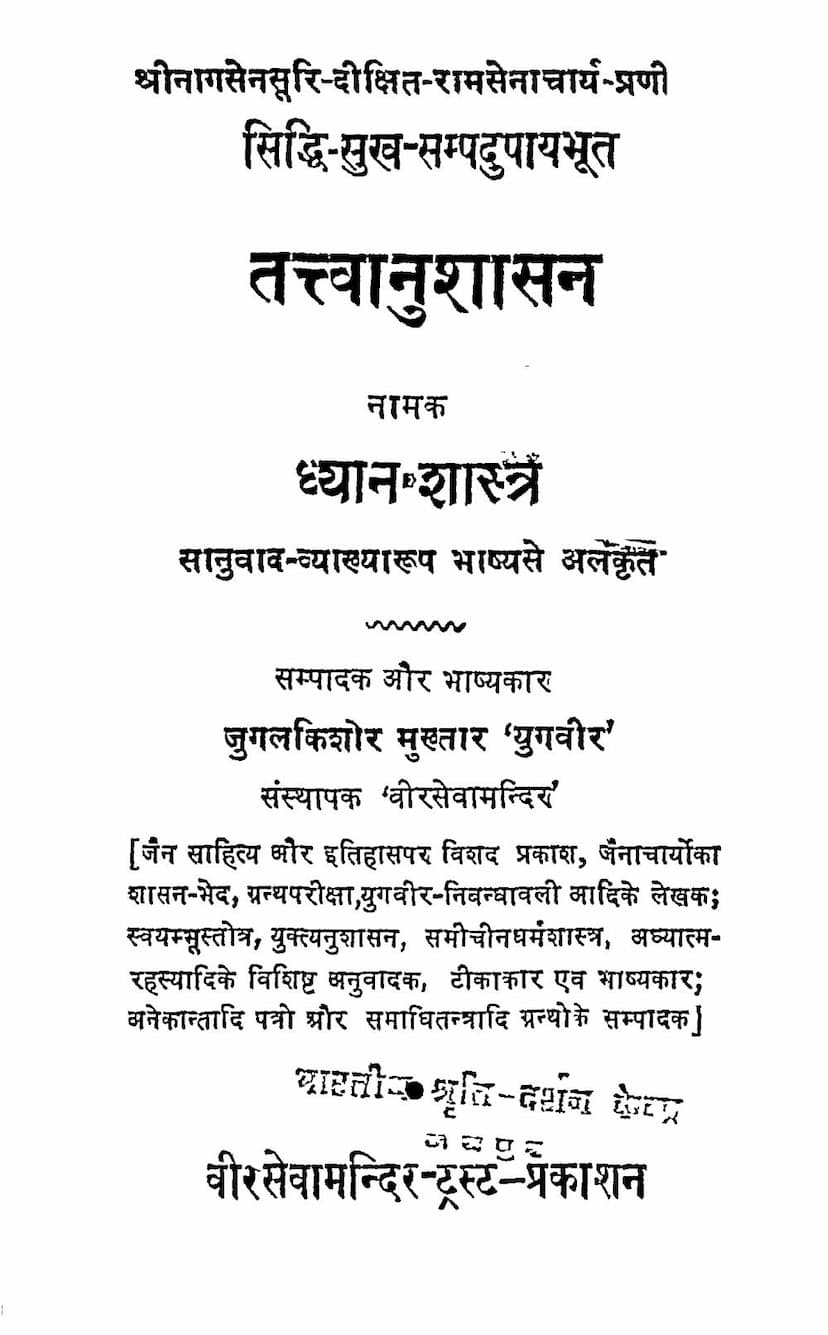Tattvanushasan Namak Dhyanshastra
Added to library: September 2, 2025

Summary
Here is a comprehensive summary of the Jain text "Tattvanushasan Namak Dhyanshastra" by Jugalkishor Mukhtar, based on the provided pages:
Title: Tattvanushasan Namak Dhyanshastra (A Treatise on Meditation named Tattvanushasan) Author: Āchārya Rāmasena (corrected from previous misattributions) Commentator & Editor: Pandit Jugalkishor Mukhtar 'Yugveer' Publisher: Veer Seva Mandir Trust, Delhi Publication Date: December 11, 1963
Overview:
The "Tattvanushasan Namak Dhyanshastra" is an ancient Jain text on meditation, authored by Āchārya Rāmasena. This edition, meticulously edited and expounded with a Hindi commentary by Pandit Jugalkishor Mukhtar, aims to present a pure and modern scholarly rendition of this valuable work. The book focuses on Dhyana (Meditation) as the primary means to achieve liberation (Moksha), explaining both the ultimate (Nishchaya) and practical (Vyavahara) paths through this practice. The work also clarifies authorship and corrects historical misconceptions.
Key Aspects and Content:
-
The Title "Tattvanushasan": The name "Tattvanushasan" is appropriate as the text expounds the true nature of reality (Tattva) and instructs on what is to be accepted (Upadeya) and what is to be rejected (Heya). This includes the principles of soul (Jiva) and non-soul (Ajiva) and their interactions, leading to liberation.
-
The Title "Dhyana Shastra": The text is also known as a "Dhyana Shastra" or "Dhyana Grantha" because its primary subject matter, for the most part, is meditation. It outlines the process and significance of meditation for spiritual development and liberation.
-
Authorship and Chronology:
- Correct Author: Pandit Jugalkishor Mukhtar has definitively established that the author is Āchārya Rāmasena, not Nāgasena, as was previously misattributed due to manuscript variations.
- Teachers: Rāmasena was initiated by Muni Nāgasena and received scriptural knowledge from Virachandra, Subhadeva, Mahendradeva, and Vijayadeva.
- Time Period: Based on internal evidence (citations of earlier works like those of Kundakunda, Umāsvāti, Samantabhadra, Pujyapāda, Akalanka, and Jinasena) and external evidence (quotations by Āshādara in his commentary on Istopadesa, completed before 1228 AD), Rāmasena is estimated to have flourished around the last quarter of the 10th century Vikrama era (circa 950 AD).
-
Subject Matter of Tattvanushasan:
- Moksha Marga: The text elucidates the path to liberation through meditation, covering both the Nishchaya (ultimate reality) and Vyavahara (practical conduct) aspects.
- Types of Meditation: It categorizes meditation into four types: Ārtta (sorrowful), Raudra (fierce), Dharma (righteous), and Shukla (pure). Dharma and Shukla dhyana are identified as the righteous paths leading to Moksha.
- Dharma Dhyāna: The eight aspects of Dharma Dhyāna are explained.
- Focus on Concentration: The work emphasizes the importance of unruffled concentration of mind for destroying karmas and achieving self-realization.
- Methodology: It details methods for achieving concentration, including meditation on the Maha-mantra and reflection on various spiritual topics.
- Accessories and Procedures: The author expounds on the various accessories, procedures, and attainments necessary for cultivating Dhyāna.
-
Commentary and Editing:
- Pandit Jugalkishor Mukhtar undertook extensive research, consulting multiple manuscripts (five are described in detail: Jaipur, Arrah transcript, original of Arrah, another Jaipur, and Amer) to produce a critical edition.
- He provides a systematic Hindi translation and a detailed commentary ("Bhashya") for each verse, explaining the nuances and specialities of the content.
- The commentary is supported by citations from related Jain works.
- A lengthy introduction (Preface) is included, divided into ten sections, covering the work's name, manuscripts, author's details, teachers, chronological placement, and a critical review of earlier editions.
-
Earlier Editions: The text has been published previously, but often with misattributions of authorship and without sufficient critical apparatus. Mukhtar's edition aims to rectify these shortcomings.
-
Dedication: The work is respectfully dedicated to Muni Shri Samantabhadra, honoring his virtues and his contribution to Jain knowledge.
-
Free Distribution: The publication of this edition was made possible through the support of the Devendra Kumar Jain Trust, Najibabad, and it is being distributed free of cost for the benefit of the public.
-
Key Principles Expounded:
- Dhyana as the means to Moksha: The central theme is that liberation is attained through meditation.
- Upadeya vs. Heya: Distinguishing between what leads to liberation (Upadeya) and what causes bondage (Heya).
- Path of Liberation: Outlining the path through Samyaktva (right faith), Samyak-Jnana (right knowledge), and Samyak-Charitra (right conduct), achieved through Dhyana.
- Karma Theory: The underlying principles of karma and its destruction through spiritual practices like Dhyana are implicitly present.
- Self-Realization: The ultimate goal of meditation is the realization of the true nature of the self.
-
Scholarly Contribution: Pandit Jugalkishor Mukhtar's work is highly praised for its mature scholarship, extensive research, indefatigable industry, and argumentative zeal in establishing correct authorship and providing a thorough explanation of the text.
In essence, this edition of "Tattvanushasan Namak Dhyanshastra" is a significant contribution to Jain literature, offering a refined presentation of Āchārya Rāmasena's insights on meditation as the supreme path to spiritual liberation, meticulously researched and explained by Pandit Jugalkishor Mukhtar.